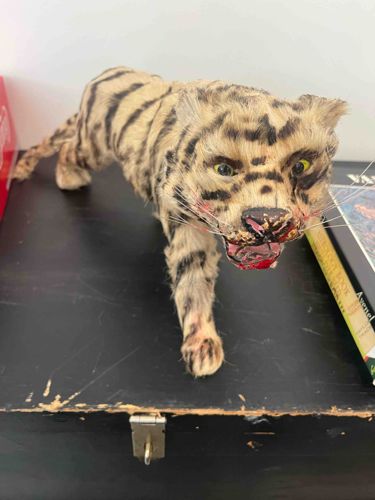
Taxidermied Tiger Cub / Wild Cat Specimen
The item is a taxidermied specimen of a small felid, likely a young tiger or a similarly marked wild cat, mounted in a stalking or prowling pose. It is depicted with a low posture, front legs extended forward, and its head turned towards the viewer, suggesting an active, predatory stance. The fur is primarily light beige or cream with distinct black stripes, characteristic of a tiger's pelt. The stripes are irregular in shape and distribution, as expected from natural patterning. The eyes are artificial, glass or plastic, with a striking yellow-green iris and narrow pupils, giving it a fierce and lifelike gaze. The mouth is open, revealing a red-painted interior and what appear to be small, pointed teeth, although the detail on these is somewhat obscured. There are visible signs of wear and age, particularly around the face where the fur appears matted and discolored, especially around the snout and chin. Reddish-pink stains are present around the muzzle, resembling blood, which might be an intentional artistic addition to enhance its predatory appearance or a sign of applied pigment degrading over time. The whiskers are mostly absent or very short, which is a common issue with older taxidermy due to fragility. The ears are relatively small and rounded, proportionate to the head. The overall construction suggests a solid, form-based mount rather than a skin rug. The condition indicates significant age; the fur shows some matting and possibly thinning in areas, and there is a visible seam or imperfection around the lower jaw/chin area where the fur meets, suggesting the mounting technique. The craftsmanship for the body appears reasonable, capturing the natural musculature of a feline, but the facial detailing, particularly the coloration, suggests a more rustic or older taxidermy style. No maker's marks or signatures are immediately visible. The piece appears to be from the mid-to-late 20th century, given the style and apparent material degradation.
AI-Generated Appraisal Disclaimer
Estimated Value
$800-1,500
Basic Information
Category
Taxidermy / Decorative Arts
Appraised On
November 28, 2025
Estimated Value
$800-1,500
Item Description
The item is a taxidermied specimen of a small felid, likely a young tiger or a similarly marked wild cat, mounted in a stalking or prowling pose. It is depicted with a low posture, front legs extended forward, and its head turned towards the viewer, suggesting an active, predatory stance. The fur is primarily light beige or cream with distinct black stripes, characteristic of a tiger's pelt. The stripes are irregular in shape and distribution, as expected from natural patterning. The eyes are artificial, glass or plastic, with a striking yellow-green iris and narrow pupils, giving it a fierce and lifelike gaze. The mouth is open, revealing a red-painted interior and what appear to be small, pointed teeth, although the detail on these is somewhat obscured. There are visible signs of wear and age, particularly around the face where the fur appears matted and discolored, especially around the snout and chin. Reddish-pink stains are present around the muzzle, resembling blood, which might be an intentional artistic addition to enhance its predatory appearance or a sign of applied pigment degrading over time. The whiskers are mostly absent or very short, which is a common issue with older taxidermy due to fragility. The ears are relatively small and rounded, proportionate to the head. The overall construction suggests a solid, form-based mount rather than a skin rug. The condition indicates significant age; the fur shows some matting and possibly thinning in areas, and there is a visible seam or imperfection around the lower jaw/chin area where the fur meets, suggesting the mounting technique. The craftsmanship for the body appears reasonable, capturing the natural musculature of a feline, but the facial detailing, particularly the coloration, suggests a more rustic or older taxidermy style. No maker's marks or signatures are immediately visible. The piece appears to be from the mid-to-late 20th century, given the style and apparent material degradation.
Get Your Items Appraised
Instant estimates of your treasures with AI-powered instant appraisals